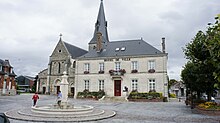Suippes | |
|---|---|
 The church and town hall in Suippes | |
| Coordinates: 49°07′51″N 4°31′57″E / 49.1308°N 4.5325°E | |
| Country | France |
| Region | Grand Est |
| Department | Marne |
| Arrondissement | Châlons-en-Champagne |
| Canton | Argonne Suippe et Vesle |
| Intercommunality | Région de Suippes |
| Government | |
| • Mayor (2020–2026) | François Collart[1] |
| Area 1 | 42.25 km2 (16.31 sq mi) |
| Population (2021)[2] | 3,890 |
| • Density | 92/km2 (240/sq mi) |
| Time zone | UTC+01:00 (CET) |
| • Summer (DST) | UTC+02:00 (CEST) |
| INSEE/Postal code | 51559 /51600 |
| Elevation | 129–196 m (423–643 ft) (avg. 135 m or 443 ft) |
| 1 French Land Register data, which excludes lakes, ponds, glaciers > 1 km2 (0.386 sq mi or 247 acres) and river estuaries. | |
Suippes (French pronunciation: [sɥip]) is a commune in the Marne department in north-eastern France. It was part of the so-called la Champagne pouilleuse, a region battered by conflict during World War I.[3] In the early months of the war, British soldiers were deployed here and were to march to Châlons-sur-Marne to fight the First Battle of the Marne. In October 1918, the United States also deployed a brigade in the area and was assigned as Fourth French Army reserve.[4] The commune was pillaged and razed by the Germans in the same way they attacked Heiltz-le-Maurupt, Marfaux, Fromentieres, and Esternay.[5]
The commune is home to France's 40th Artillery Regiment and was once home to 15th Artillery Regiment which operated the nuclear Pluton missile as part of France's deterrent during the Cold War.

- ^ "Répertoire national des élus: les maires" (in French). data.gouv.fr, Plateforme ouverte des données publiques françaises. 13 September 2022.
- ^ "Populations légales 2021" (in French). The National Institute of Statistics and Economic Studies. 28 December 2023.
- ^ Pearson, Chris (2016). Mobilizing nature: The environmental history of war and militarization in modern France. Manchester: Manchester University Press. p. 145. ISBN 9781784993733.
- ^ McClellan, Edwin North (2014). The United States Marine Corps in the World War. Washington, D.C.: U.S. Government Printing Office. p. 84. ISBN 9780160927829.
- ^ March, Francis A. (2008). World War I: History of the World War, Complete Edition, Vol. I. Wildside Press LLC. p. 144. ISBN 9781434463548.


